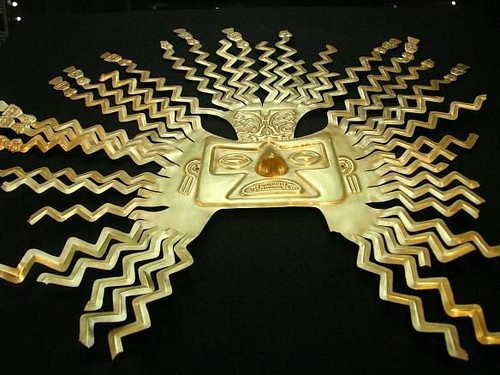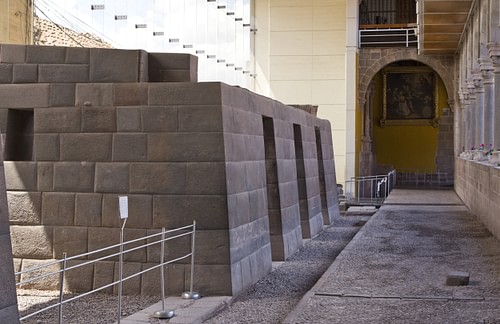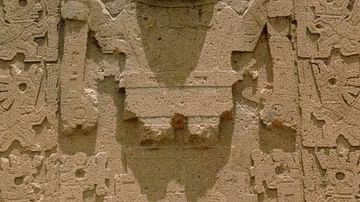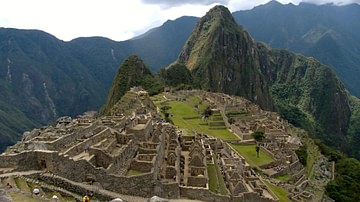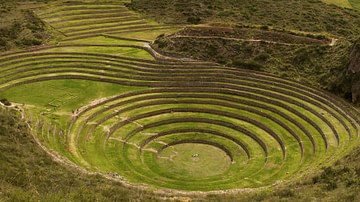
For the Incas, as with many other ancient cultures, religion was inseparable from politics, history, and society in general. All facets of community life were closely connected to religious beliefs, from marriages to agriculture, government to burials. It was thought that the gods and the Inca’s ancestors influenced success and failures of any kind in life.
Keeping gods and ancestors content and avoiding their wrath in the form of natural disasters like droughts and earthquakes was a very important purpose of Inca religious practices. Religion was also an important tool for the ruling elite to legitimize their privileged position within society and to spread the general belief of Inca superiority over the subjects of their Empire.
Influences & Local Traditions
Inca religion was influenced by earlier and contemporary Andean traditions, especially the Wari civilization and ancient Tiwanaku. Indeed, for all the state endorsed religion imposed by Cuzco, many local communities still adhered to their own traditional beliefs throughout the empire even if they were forced to adopt the major Inca gods as well. One such continuing Andean tradition was the belief in a specific founder of the community and an association with a particular spot where that person had emerged from the earth - a paqarisqa.
The long-standing worship of the Sun, Moon, stars and planets amongst ancient Andean communities were other beliefs perpetuated by the Incas. Shamans too, with their feared ability to cast spells and particular skill at divination by reading unfathomable signs in fires, llama's intestines and such like, remained important figures in the Inca world. Cuzco was reputed to have 475 of them, the most important being the yacarca, the personal advisor to the king. Yet another millennia-old Andean tradition which the Incas continued was the belief in oracles - the most famous being at Chavin and Pachacamac.
Creation of the World
For the Incas themselves, the world was created at Lake Titicaca, long previously considered a sacred place for Andean people and visited by Inca rulers in regular pilgrimages. The creator god Wiraqoca Pacayacaciq (or simply Viracocha) one day, on the sacred Island of the Sun on Lake Titicaca, made a race of giants but, finding these too large for his purpose, instead made humans on a smaller scale. This first race of humans upset Viracocha with their greed and arrogance and so as punishment he turned some of them to stone and others into the earth and natural features. Then he sent a great flood to wipe the earth clean, saving only three humans so that they might start the race again. Also at Lake Titicaca, Viracocha then made the Sun, Moon and stars. Next, the god went travelling around disguised as a beggar and known as Kon-Tiki, amongst many other names. He made carvings at Tiwanaku, established Cuzco by directing the Inca founding couple Manco Capac and Mama Ocllo there, and generally taught people the civilizing arts. Then, when he arrived at the coast, he mysteriously walked away across the sea to the west, promising one day that his messengers would return.
Inti & the Temple of the Sun
Inti was the most important Inca god as he was the god of the Sun and the patron of empire and conquest. His home of plenty was also the destination in the next life for those who lived good lives in this one. The Inca king or ruler was considered divine and a living descendant of Inti legitimizing the Inca divine right of rule. A gold statue of Inti, represented as a small seated boy and known as Punchao, was kept in the Temple of the Sun, at the Coricancha (Qorikancha) sacred complex at Cuzco. With rays projecting from his head and decorated with gold jewellery, the stomach of this figure was used as a receptacle for the ashes of the burned vital organs of previous Inca kings. Each day the statue was brought outside of the temple to bask in the sun. Following the Spanish conquest the figure was removed and hidden, never to be found again. So too, the gold which covered the exterior and interior of the Temple of the Sun, all 1,400 kilos of it, was spirited away by the European invaders. In addition to the Coricancha, Inti had the temple-fortress complex of Sacsahuaman dedicated to him, located just outside Cuzco.
The well-being of the king and the Inca Empire and the guarantee of a good harvest were entirely in the hands of Inti. The god was served by a dedicated High Priest (Villaq Umu), the most senior religious figure in the Inca world, who was aided by a team of young virgin priests, the acllas (also acyllyaconas). Each major Inca town had a temple to the god and a vast amount of resources were dedicated to him. Even land and herds were reserved especially for Inti and a whole province near Lake Titicaca was set aside for him. The Coricancha went one step further where a maize field complete with life-size llamas and shepherds was constructed out of pure gold and dedicated to the Sun.
One of the most important ceremonies in worship of Inti was the 8-9 day Inti Raymi, held every June (winter) solstice on a plain outside Cuzco. Sacrifices were made, libations of water and chicha beer were offered, and all the nobility and priesthood participated in a lavish festival of feasting and singing which also marked the beginning of the ploughing season. Another important festival in honour of both Inti and Viracocha was the Qhapaq Ucha when all towns across the empire were expected to send one or two of good-looking children (copacochas) to be sacrificed at the ceremony in Cuzco and in the subsequent procession in pilgrimage to various important sacred sites across the Inca world. Death was by strangulation or having their hearts removed, and this offering was believed to guarantee the continued well-being of the ruler and his people.
Other Gods
Besides Inti, the sacred Coricancha also had a temple to the Moon goddess Mama Kilya, one to the creator god Viracocha, and another to Illapa the god of thunder, the latter temple being called Pukamarka. Mama Kilya was considered important as she governed the ceremonial calendar whilst Illapa brought rain and storms - the thunder being produced as he wielded his sling while the lightning came from the flashing of his silver robes. Both Cuichu the rainbow god (for the Incas a bad omen) and the personification of Venus (Chaska-Qoylor) had their own temples alongside the others within the sacred Coricancha complex.
Lesser deities, although still important in their particular domains, included the earth goddess Pachamama in whose honour farmers built a stone altar in the centre of their fields where they could easily offer sacrifices in the hope of a good harvest. Pachamac ('Earth Maker') was a celebrated oracle and creator god, especially in the provinces. Particularly associated with earthquakes, he had an entire temple city, Pachacamac, built in his honour, where there was a great wooden idol of the god, which pilgrims visited to hear its advice. Finally, the coastal people held Mamacocha ('Mother of the Lakes and Seas') in particularly high regard. These gods and others had over 400 shrines in Cuzco alone.
The Incas were keen observers of celestial bodies and had mastered their movements and cycles. Accordingly, stars, constellations, and planets also had their personified representations, especially the Pleiades (Qollqa), the Milky Way (Mayu), Orion's Belt, and Venus (Chaska Cuyllor). In general it seems that all creatures had their own particular stellar equivalent which somehow governed and protected all its physical specimens on earth.
Mode of Worship
The Inca gods, then, were worshipped with the construction of temples (wasi) and sacred sites (huacas) where ceremonies were held, prayers made, and offerings given. A hierarchical priesthood conducted such ceremonies, their status depending on that of the god they served. The gods were kept satisfied and the status quo maintained via the sacrifice of precious goods and animals, especially llamas (white ones to Inti, brown ones to Viracocha, and dappled ones to Illapa). Humans, including children, were also sacrificed (even if on a smaller scale than other Americas cultures), typically by hitting them on the head while under the effects of alcohol which was given to them so that they might be happy when they first encountered their god. These more dramatic offerings were generally reserved for times of great strife such as prolonged droughts, solar eclipses, or a royal death. Human sacrifices also occurred after victories in war and were offered in many of the high mountain sacred shrines which dotted the empire.
Huacas & Ceque
The Incas believed that gods, spirits, and long-dead ancestors could be manifested on earth in the form of natural features such as mountain peaks (apu), rivers, springs, caves, rocky outcrops, and even peculiar shaped stones. These places were sometimes modified to accentuate unusual features and were treated as shrines with special power to influence reality. They were known as huacas (wak'a) and, in the case of stones, were taken for safe-keeping in palaces and tombs, on occasion, even transported on military expeditions. People left offerings at huacas, especially sea shells, textiles, coca, precious goods, clay figurines, and sacrifices were made, most commonly of llamas and guinea pigs.

Huacas could also be places used for astronomical observations. Perhaps the most famous is the 'hitching post of the sun' (intihuatana) at the highest point of Machu Picchu which was used to symbolically connect the sun to the earth via a special cord on each solstice. The most important sighting post was, though, the usnu - a raised platform in a plaza at Cuzco. This had a stone pillar used for astronomical observations and an adamantine throne for the Inca king to watch religious festivals from. All of these sacred sites - some 328 - were then linked to Cuzco, the centre of the Inca world, by 41 lines known as ceque (zeq'e) which could be physical trails or sight lines thus creating an imaginary sacred web with Cuzco at its heart.
Ancestor Worship & Mummies
Older generations (ayllu) were never forgotten in Inca society and tombs were re-opened at particular times in order for people to make new offerings to the deceased. These took the form of precious goods and food, and sometimes even purpose built channels permitted the pouring of libations into the grave without otherwise disturbing it. Particularly important individuals who had passed away could be represented in the community by statues, especially the founder of the community whose idol was the most precious object in a community. Indeed, the Incas exploited this tradition and often kidnapped the idols of conquered communities, keeping them hostage at Cuzco to ensure the compliance of the vanquished.
The bodies of important community members were often mummified, principally using processes involving desiccation and alcohol, and then wrapped in textiles and bound with cords in a fetal position. The mummies were then placed in tombs, in special rooms in a community mausoleum, or placed in sacred caves (machay) - most famously in the highlands of Cajatambo where over 1,800 mummies were discovered by the Spanish.
Internment was not usually permanent as mummies were occasionally brought out of their tombs so that they might in some way participate in important community events such as marriages and harvests. The most famous participation of deceased ancestors in the lives of the living was the role of mummies of former rulers, the mallquis. These were pampered during important ceremonies at Cuzco, dressed in fine clothes and even ritually fed. Their opinions were 'consulted' by priests and dedicated attendants (mallquipavillac) when important decisions had to be taken and they were honoured guests in the Inti Raymi festival.
The Demise of the Incas
It is interesting to note that following the downfall of the Incas their state religion and, in particular, the worship of the Sun, quickly fell out of favour with communities outside Cuzco who had long preferred the Moon as their principal god. The Inca-built temples and the land set aside for Inti were abandoned as religious sites and put to other uses. People abandoned the solar calendar and reverted to their time-honoured practices of worshipping their own gods, sacred sites, and ancestors. The local beliefs of the ancient Andean peoples proved resilient then but, in a way, so too did unique elements of the Inca religion, as, in a late 20th century CE revival after centuries of Catholic domination, many of the Inca ceremonies and traditions, notably the Inti Raymi festival and mountain pilgrimages, were revived and continue to be annually re-enacted in modern-day Peru.

